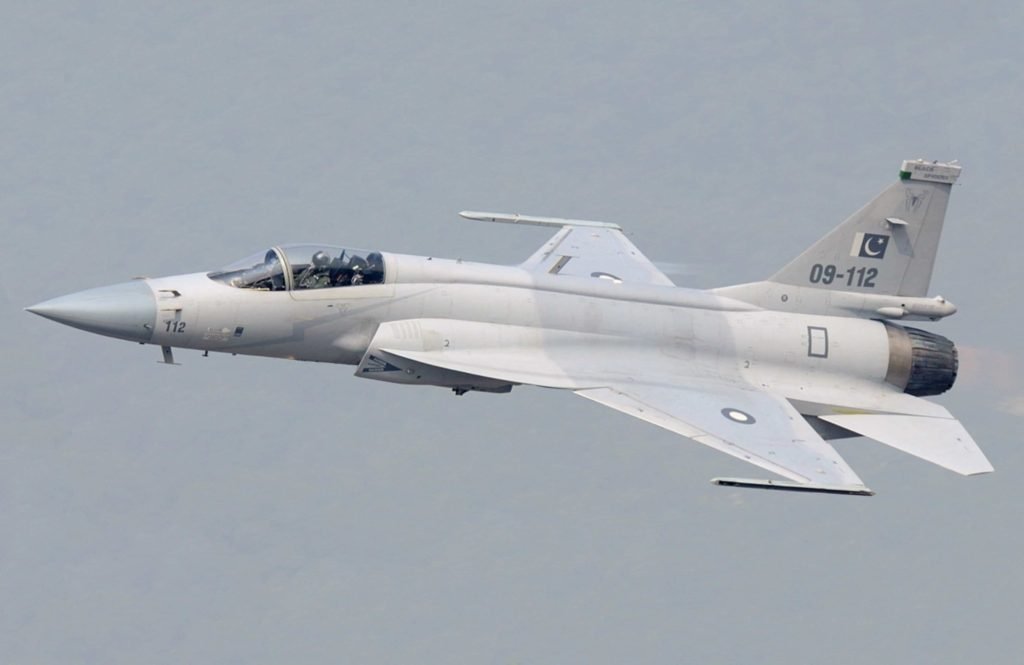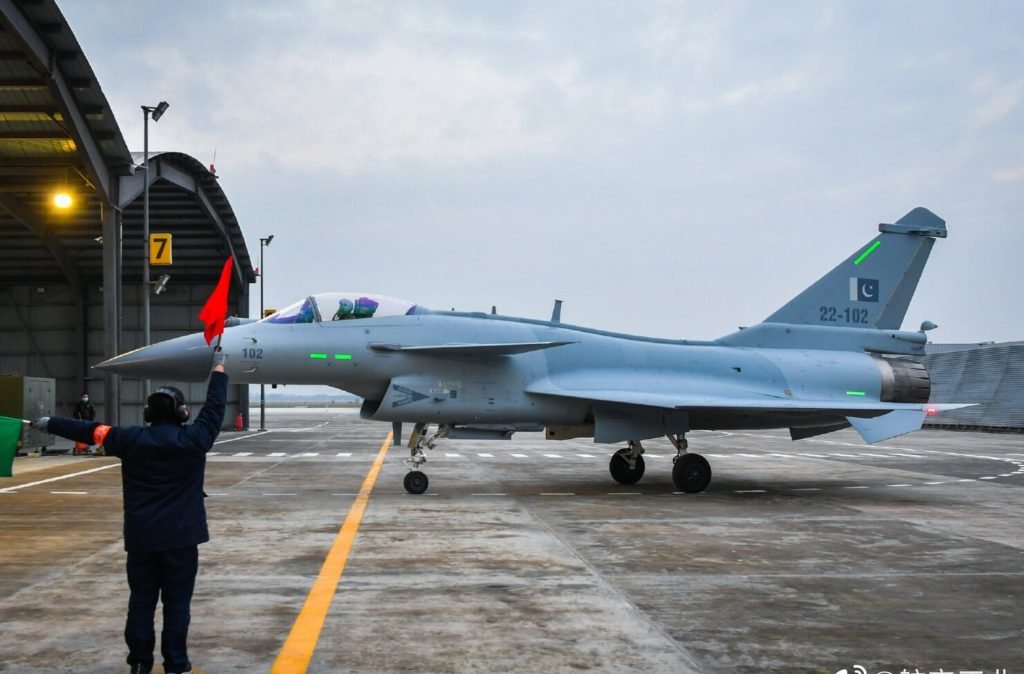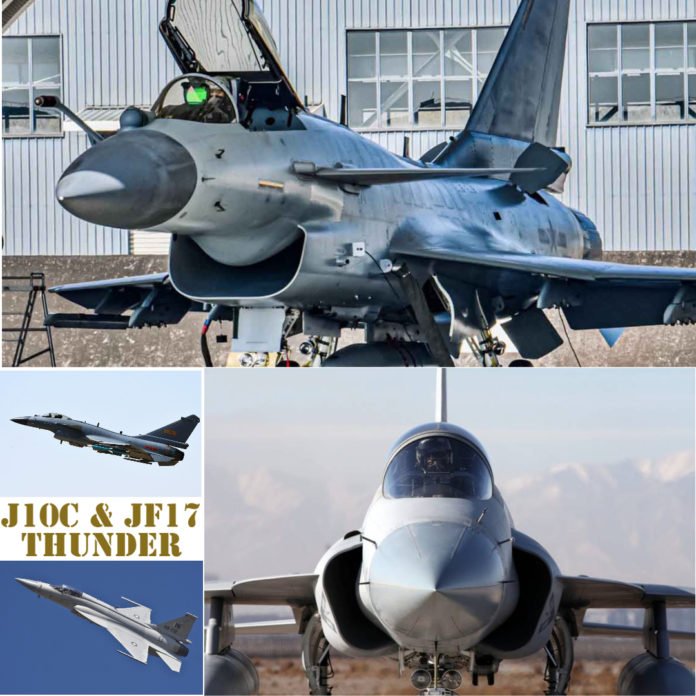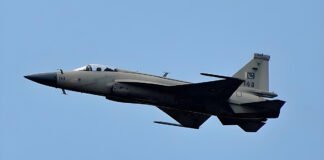To strengthen its combat prowess, Pakistan has stepped up its defense capabilities and has recently inducted Chinese acquired multi-purpose J-10C fighter jets into its Air Force. Though rumors about Pakistan buying the J-10 have been circulating for a long, its closest announcement was only made last December 29. However, finally, the induction of J-10C fighter jets happened on Friday, March 11, at Minhas Air Base.
In a simple ceremony attended by Prime Minister Imran Khan, the heads of the three services, the Chinese ambassador, and others, the Pakistan Air Force unveiled its latest addition – the next-generation Chinese fighter jet, the J-10C.
Although PAF is currently flying a fleet of jets, including JF-17, that has been effectively guarding the aerial boundaries of Pakistan since inducted by the PAF in February 2010. But after, the arrival of Chinese-made J-10C aircraft in the Pakistan Air Force – has sparked a debate in the region regarding how these aircraft differ from the previously owned JF-17.
Here is a brief comparison of the JF-17 vs J-10C.
JF-17 Fighter Overview

Joint Fighter-17 (JF-17) is an aircraft jointly developed by Pakistan’s Aeronautical Complex (PAC) and China’s Chengdu Aircraft Corporation (CAC).
The Pakistan Aeronautical Complex (PAC) possesses a 58% share in the co-production of the JF-17 airframe. In November 2009, PAC completed the final assembly and flight testing of PAC’s first production of the JF-17.
Specifications and Features
This highly capable, air-to-air, and air-to-surface multi-role fighter is an advanced, lightweight, day/night, all-weather aircraft. JF-17’s advanced avionics, optimally integrated sub-systems, computerized flight controls, and ability to use the latest weapons give it a decisive edge over its counterparts.
Aerodynamically, the JF-17 Thunder has a conventional layout. Its engine is a Klimov RD-93 turbofan with an afterburner, which is a derivative of the RD-33 found in the MiG-29.
With outstanding tactical manageability at low and medium altitudes, the aircraft has adequate firepower, agility, and combat survivability, making it a powerful platform for any air force.
Critical components of the JF-17
Among the critical components of the JF-17 avionics are the KLJ-7 Al radar and Weapon Mission Management Computer (WMMC), both of which have been problematic.
- KLJ-7 radar displays degraded behavior, and its operation and maintenance are also problematic. Meanwhile, the WMMC has limited capacity, and several modules have shown high failure rates, including the Main Computer.
- Due to WMMC malfunction, Launch Zones of air-to-air missiles beyond visual range have shrunk during combat exercises. And due to unreliability, PAC is now trying to manufacture WMMCs indigenously.
- The weapons load is not impressive also. The aircraft’s integral 23 mm gun has stopped firing in the air, and now, it has problems with 23 mm rounds bursting.
JF-17’s performance issues are attributed mainly to its single RD-93 engine, which is notoriously difficult to maintain. Besides, the JF-17 has other problems that include “Nose Landing Gear shimmies while taxing as well as nose wheel vibration”. Additionally, ventral trails have been found cracked, indicating poor metallurgy.
Variants of JF-17
- JF-17A Block 1
- JF-17A Block 2
- JF-17B Block 2
- JF-17 Block 3
Operators of JF-17
As of now, besides Pakistan and China, Myanmar and Nigeria are countries operating JF-17.
J-10C Overview

Jian 10 (J-10) is an indigenous Chinese multi-role fighter developed by Chengdu Aircraft Industry.
The aircraft carries the NATO designation ‘Firebird’ and is also called ‘Vigorous Dragon.’
Specifications and Features
The J-10 is a single-engine, multi-role fighter designed for air-to-air warfare and strike missions, and it is capable of operating in all weather conditions. Air-to-air and surface-to-surface missiles can be fired from the aircraft, which hit targets beyond the human eye’s reach with BVR (beyond the range of vision).
There is also a 23 mm machine gun on board, as well as L-15 missiles that can reach 200 km from the air, PL-8 missiles that reach close range, and J10C laser-guided bombs that can mass more than 500 kg to hit the ground in free fall.
J-10C, with its state-of-the-art radar, detects up to ten targets simultaneously and hits four at a time. A 4.5 generation jet fighter, the J10C comes with a Gold Quality Radar. It is capable of identifying the enemy in current war conditions and is able to withstand Jamir attacks.
The J-10 has 11 external hardpoints that can carry a variety of weaponry. It is also capable of storing target acquisition systems, navigation pods, and supplementary fuel tanks. The aircraft can refuel while in flight.
The J-10C is said to be remarkably similar to the F-16s that form the backbone of Pakistan’s air force. Still, it is a more attractive alternative for Islamabad because the F-16 is tethered to several US requirements.
Variants of J-10C
- J-10A
- J-10AH
- J-10S
- J-10SH
- J-10B
- J-10B TVC Demonstrator
- J-10C
- J-10CE
Operators of J-10C
As of now, Pakistan is the other country besides China that will operate J-10C.
JF-17 vs J-10C: How do they differ?
Both the JF-17 and J-10 are lightweight fighter aircraft, but their weights differ considerably. The J-17s are considered “very light” fighters. Their engines are from mediumweight fighters instead of heavyweights, and they use a single configuration. In contrast, J-10 is also a lightweight jet. However, it borrows an engine from the heavyweight fighter class and instead uses a twin configuration.
By being lighter and using a smaller engine, the JF-17 is not only significantly cheaper to manufacture but also easier and less expensive to operate than the J-10. A low maintenance requirement and high attack and availability rate make the JF-17 comparable to the Gripen. In comparison, the J-10 is significantly more expensive to operate and produce but is still quite affordable in comparison to jets of the same weight as the J-16 and has superior performance.
Though Pakistan has acquired a squadron of J-10C aircraft or may replace some of the older F-16 aircraft, the JF-17 Block 3 aircraft are expected to account for the vast majority of new acquisitions and may well be purchased in greater numbers than older JF-17 models.
Also, according to Shi Hong, chief executive editor of the Chinese magazine, J-10C will not replace the JF-17 in Pakistan but will form a combination with it, giving Pakistan enhanced combat capabilities.
Let’s look at the technical specification of JF-17 vs J-10C.
JF-17 vs J-10C: Technical Specifications
Basic Description
| Attributes | JF-17 | J-10C |
| Type | Multirole combat aircraft | Multirole combat aircraft |
| Origin | China/Pakistan | China |
| Generation | 4th generation | 4.5th generation |
| Developed | 2007 | 2002 |
| Unit cost | 25–32 million $ | 27.8 million $ (2010) |
Physical Parameters
| Features | JF-17 | J-10C |
| Length | 49 ft | 55 ft 2 inches |
| Height | 15.5 ft | 18 ft 8 inches |
| Wingspan | 31 ft | 32 ft 2 inches |
| Empty Weight | 14,520 lb | 9,750 kg |
| Fuel Capacity | 12852.95 lb | 16270.11 lb |
Performance Parameters
| Characteristics | JF-17 | J-10C |
| Maximum Speed | Mach 1.6 | Mach 1.8 |
| Stall speed | 150 km/h | 200 km/h |
| Combat range | 1,450 km | 2,600 km |
| Ferry range | 3,481 km | 2,950 km |
| Service ceiling | 55,510 ft | 56,000 feet |
| G limits | +8/-3 (limited by the flight control system) | +9/-3 |
| Thrust/weight | 1.07 | 1.10 |
| Rate of climb | 59,000 ft./min. | 59,000 ft./min. |
Armament
| JF-17 | J-10C | |
| Cannon | 1 x 23 mm or 30 mm | 23 mm cannon |
| Missiles | PL-7, PL-8, PL-9, AIM-9P short-range air-to-air missiles, PL-12 medium-range air-to-air missiles | PL-12 and PL-8 air-to-air missiles |
| Bombs | free fall or laser-guided bombs | free-fall bombs, 500 kg laser-guided bombs |
| Other | pods with 90 mm unguided rockets |





